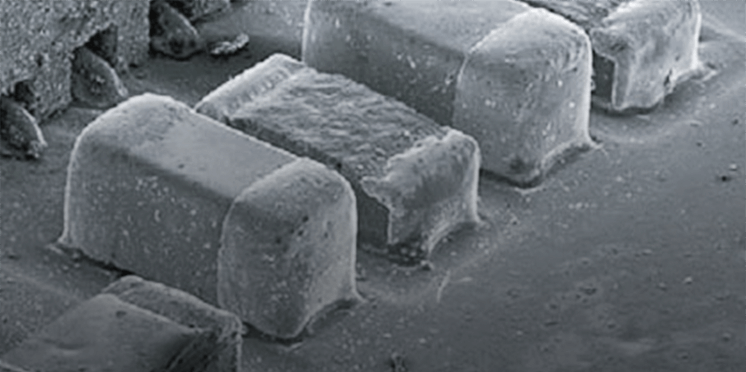de-scan
de-scan
De-scan means to bring the electron beam deflected from the optical axis back to the optical axis using a two-stage deflector coil, the deflection being caused by illumination position or illumination angle of the incident electron beam onto a specimen. De-scan is applied mainly to the following two cases.
1) When the incident electron beam is scanned over a wide area of a specimen, the electron beam can stray off the optical axis at the peripheral part of the scanned area. Then, the incidence position or the incidence angle of the electron beam to a STEM or EELS detector whose center is adjusted to the optical axis deviates from the axis.
In the case of STEM; if an electron beam passing through a scan point of the specimen deviates from the STEM detector, the STEM image intensity is varied compared with the correct intensity which should be detected.
In the case of EELS; if an electron beam passing through a scan point of the specimen does not run on the center of the EELS detector or runs obliquely to the optical axis of the detector, the energy value of the EELS spectrum cannot be correctly measured.
To avoid such an undesirable electron-beam position or angle to the STEM or EELS detector, a two-stage deflector coil in the image-forming lens system is operated synchronously with the beam scan to always bring back the electron beam to the center of the detector and/or parallel to the optical axis.
2) In the case of precession electron diffraction, to precess the incident electron beam onto a certain point on a specimen, a two-stage deflector coil in the illumination lens system is used. The first deflector coil tilts the incident electron beam to a certain angle (up to approximately 5°), and then the second deflector coil compensates the displacement of the tilted incident electron beam from the optical axis. Then, the electron beam passing through the specimen runs oblique to the optical axis. A two-stage defector coil in the image-forming lens system is used to bring back the electron beam to run on the optical axis. A precession diffraction pattern is obtained by such operation of the two-stage defector coils.
1) When the incident electron beam is scanned over a wide area of a specimen, the electron beam can stray off the optical axis at the peripheral part of the scanned area. Then, the incidence position or the incidence angle of the electron beam to a STEM or EELS detector whose center is adjusted to the optical axis deviates from the axis.
In the case of STEM; if an electron beam passing through a scan point of the specimen deviates from the STEM detector, the STEM image intensity is varied compared with the correct intensity which should be detected.
In the case of EELS; if an electron beam passing through a scan point of the specimen does not run on the center of the EELS detector or runs obliquely to the optical axis of the detector, the energy value of the EELS spectrum cannot be correctly measured.
To avoid such an undesirable electron-beam position or angle to the STEM or EELS detector, a two-stage deflector coil in the image-forming lens system is operated synchronously with the beam scan to always bring back the electron beam to the center of the detector and/or parallel to the optical axis.
2) In the case of precession electron diffraction, to precess the incident electron beam onto a certain point on a specimen, a two-stage deflector coil in the illumination lens system is used. The first deflector coil tilts the incident electron beam to a certain angle (up to approximately 5°), and then the second deflector coil compensates the displacement of the tilted incident electron beam from the optical axis. Then, the electron beam passing through the specimen runs oblique to the optical axis. A two-stage defector coil in the image-forming lens system is used to bring back the electron beam to run on the optical axis. A precession diffraction pattern is obtained by such operation of the two-stage defector coils.
Related Term(s)
Term(s) with "de-scan" in the description
Are you a medical professional or personnel engaged in medical care?
No
Please be reminded that these pages are not intended to provide the general public with information about the products.




